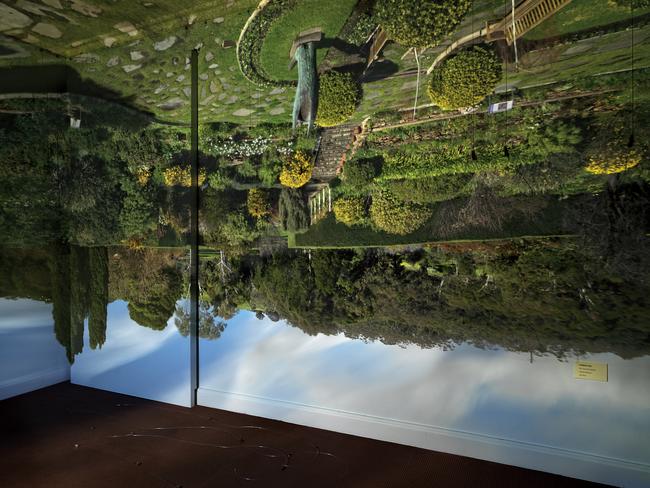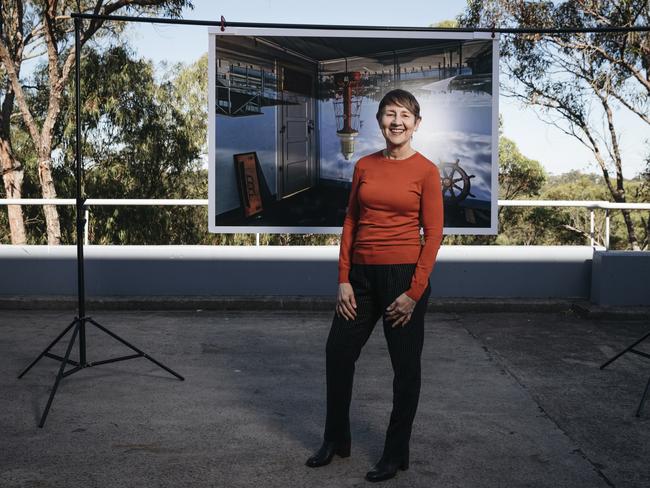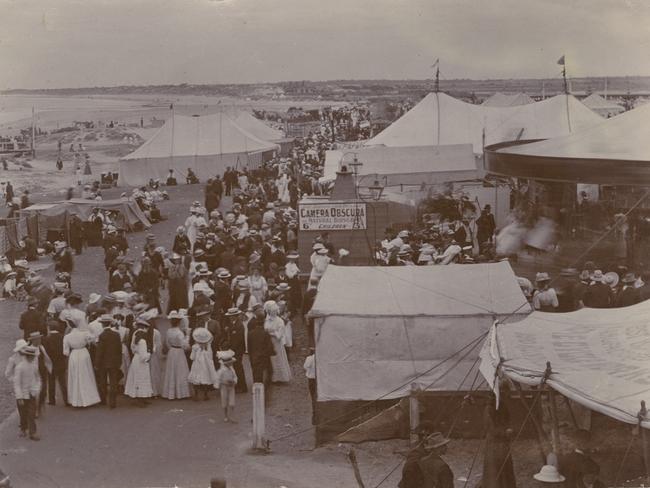Off the wall: the ancient phenomenon of camera obscura
THE ancient phenomenon of camera obscura still turns the world upside down. Photographer Robyn Stacey takes her Adelaide images on tour.
ONE of the magical things about the camera obscura, says photographer Robyn Stacey, is that in the same moment it can make you feel like you’re in the world and yet not part of it at all.
The concept is simple and ages old. All you need is a completely darkened room and a small opening (say the size of a 20c piece), which allows a bright exterior world to be projected inside.
But, as these images show, that world comes upside down and in reverse, just as your eye normally receives information before the brain flips it over.
Stacey started experimenting with the concept when she worked on a project with Sofitel in Melbourne years ago. She decided that instead of taking pictures looking out from the hotel’s rooms, she would use camera obscura (in Latin, a room that is dark) to bring that world inside.

Stacey then took photographs, using a slow shutter speed, of those projected images. Now, some of her works from around Adelaide are about to go on a two-year tour of regional South Australia, where camera obscuras will be set up in a number of locations.
The concept has been around since ancient times, perhaps 500BC in China, and then Greece and the Middle East, but Stacey says the heyday was the 16th century, when the new availability of the glass lens allowed images to be brought inside with sharper focus.
“Separating the image from the thing itself was mind blowing,” she says of the reaction of people at the time. “It is like (for us) going to the moon. How is that possible?”
Even today, people who experience it are captivated.
“When you are in the room, it’s like you’re in the world and not in the world,” she says. “You are detached. People say to me: ‘It’s meditative.’ You can see people walking down the road – and cars go around the room – but you are removed from it.”
Every room offers a different experience, she says. The image may last for 20 minutes or two or three hours, depending on the sun and time of day.
But there’s more to it than a novel way of looking at familiar subjects.
“It makes you think about vision,” she says. “How we see the world. It does pull you up and make you think a bit.”
The idea of this single pinhole source of light into a dark room went on to become the camera we know now.
But the concept has also been used for other purposes. Philosophers have cited camera obscura to make the case for alternative ways of looking at things. We might be used to seeing the world one way, but there are others. Karl Marx argued that ideology is a camera obscura because it turns reality on its head.
As Stacey says: “The magic of the camera obscura is that it makes us question what we take for granted.”
Stacey’s works will include images she took in 2016 from temporary Adelaide camera obscuras. They include the South Australian Health and Medical Research Institute (SAHMRI) building on North Tce, the Lighthouse Wharf Hotel at Port Adelaide, the garden at historic homestead Carrick Hill, and South Australian artist Hans Heysen’s studio at The Cedars, near Hahndorf.

LURED TO THE DARK SIDE
Words: Alice Clanachan
In 1937, a Mrs H. Yelland wrote in her local newspaper in Port Pirie of a visit to the Adelaide foothills, where she had witnessed “magnificent views through a camera obscura”. She had visited the kiosk of Mr J. Marshall, who constructed a camera obscura (“dark room”) perched on a hilltop at Windy Point, Belair.
The small structure housed a lens at its apex, which provided the only source of light inside the building. Mrs Yelland marvelled at the “coloured views from the hilltop”, whereby panoramic landscape views were “thrown” on to a large, round plaster block inside the small building.
In this camera obscura, Mrs Yelland saw “the Melbourne express chugging along the track below, the perfect blue of the sky with white fleecy clouds scudding across it, waving grass and windblown trees, and the vista beyond”.
In the late 19th and early 20th centuries, South Australians were an enthusiastic audience for the camera obscura. This optical device – which had a long history, having first been written about in the Greek philosopher Euclid’s Optics about 300BC – gained popularity among Australian colonists as a source of entertainment.
Far from being “magic”, the device uses robust principles of science and optics and naturally produces an upside-down image in a room of the view outside. The structures could be built in a fixed location, like Mr Marshall’s camera obscura at Windy Point, or of a more temporary nature, such as those constructed on carts which could be wheeled to exhibitions and fairs. For a small fee, the visitor could marvel at the moving coloured view that appeared on a white surface in the darkened room.
SA was home to many temporary camera obscuras, although exact numbers are uncertain. In 1892, a camera obscura was erected on the beach near the Glenelg jetty, where it stayed for more than a year. The attraction was particularly popular on holiday weekends, including Commemoration Day on December 28 (now called Proclamation Day, commemorating British settlement at Glenelg in 1836) and over Easter, when it became the “principal source of attraction”. It incited much “wonder and amusement” and contributed to an atmosphere in which one visitor remarked at being overwhelmed with “too much joy”.
In the same year the Glenelg camera obscura was constructed, a helpful column in newspapers at Kapunda and Mt Gambier gave instructions on how to create a homemade camera obscura by using a double convex glass fixed to a small hole in a curtain or blind in a darkened room. The writer advised that “the picture is most distinctly seen when the image is formed on the back of a silverized mirror”, to flip the inverted image the right way around.
South Australia’s history has perfectly coincided with the photographic age, as the colony was founded in the same year that photography was invented in 1836.
From the 1860s, the market burgeoned for portrait photography, whether in a studio or by a travelling photographer, partly due to the introduction of technology that allowed photographers to print images on paper from a glass negative. Affixed to attractive cards, these pocket-sized portraits, or cartes de visites, were relatively cheap to produce and immensely popular with the upper and middle classes.

Photography was close to the cultural heart of South Australians, who had an appetite for photographic views of their state – from its landscape to the development of infrastructure in industries such as mining, shipping and agriculture. Amid this enthusiasm, the camera obscura fulfilled a function in understanding the landscape and marvelling at the state’s cities and towns.
Camera obscuras served as a source of entertainment and education alongside another photographic technology: the magic lantern show. These involved the illumination of static photographic slides to project images on a surface, often rapidly one after another to form the illusion of a moving image and to present a narrative. They were often shown in buildings such as town halls and the more elaborate in theatres.
Travelling magic lantern operators toured the state. A Mr Dooner showed in his “Pantecnatheca” views from around the world, including images of Mt Gambier and the Blue Lake, in South Australian Institute buildings and school halls for a decade from 1867. The 19th century photographer Nicholas Caire began his career as a magic lantern operator in South Australia, delivering his last show, Dark Deeds of the Dark Ages, in Mt Gambier in 1870 before moving to Victoria.
The popularity of camera obscuras had waned by 1937, as Mrs Yelland reported that Mr Marshall’s device at Windy Point was one of only three in Australia at the time.
By the early 20th century, photography had become accessible and widespread, and the phenomenon of experiencing the separation of object and image in the camera obscura had become less exciting for the public, although Mrs Yelland clearly relished its “coloured” views after being used to black-and-white photography.
Now Robyn Stacey is bringing the camera obscura back to South Australia.
In the months before her Ray of Light tour, Stacey has been on the road, building camera obscuras in towns around SA. She has been cognisant of revealing South Australian views: of a Hahndorf streetscape or the landscape seen from the window of the Bordertown Hotel.
I hope the camera obscura makes people
think about the act of seeing, which in turn makes you think about the way that vision creates our sense of self.
Alice Clanachan is the Art Gallery of SA’s assistant curator of Prints, Drawings and Photographs
From this month until September 2020, the exhibition will tour 14 venues across regional South Australia, from Bordertown to Roxby Downs and Goolwa to Port Lincoln. A live camera obscura will be installed at six of the
14 locations.
Visit countryarts.org.au/events/ray-light-robyn-stacey/
